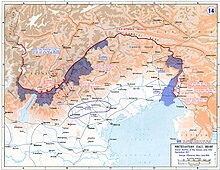Friends of the Dolomites
Dolomitenfreunde is the common abbreviation for the association “Dolomitenfreunde - Friedenswege / Le vie della pace” based in Vienna . The association was founded in 1973 by Walther Schaumann and has the purpose of "maintaining international understanding between the former opponents of the First World War (1914-1918) through historical research, development and documentation of the area of the former south-western front and also the reduction of any resentments."
The main focus of the non-profit activities of the members and volunteers, who have so far come from 20 countries (e.g. from Albania, Germany, Italy, Ireland, Austria, Poland, Russia, Switzerland, Spain, the Czech Republic and Hungary), was initially the repair of paths, the construction of shelters and emergency bivouacs in the former front area. The Dolomitenfreunde have been active on the Plöckenpass on the border between Austria and Italy since 1983 . The focus of the actions is now on the documentation of our contemporary history through the expansion of museum facilities. These are the museum 1915–1918 “From the Ortler to the Adria” in the town hall of Kötschach-Mauthen (opened on July 11, 1992) and the open-air museum in the area of thePlöcken . Together they convey a special impression of the historical events and their effects up to the present day. The immediate vicinity of both museums (12 km) offers a unique opportunity in nature, at a historical location, to gain a very personal idea of the mountain warfare in the First World War.
Implemented projects
- The first project that the association carried out in 1973 in the Fanes group consisted of repairing the path to Monte Vallon Bianco , a corner pillar of the front littered with remains of positions - this is where the first "Via della pace" was built. In the following years, further paths and via ferrata were reconstructed and bivouacs were built in the Fanes group, at Col di Lana , Hexenfels , Lagazuoi and Tofana .
- 1975 - 1977 the Dolomitenfreunde became active in Austria for the first time : the Carnic High Trail , built in the interwar period by the Austrian Alpine Association from the network of former front climbs, became isolated because the shelters and bivouacs had been partially destroyed by the events of the Second World War accommodation now after a day's hike, so the path fell into disrepair. The friends of the Dolomites proposed a working group to the PES. The procurement of materials and groceries for the volunteers were at the expense of the PES, for which the Dolomitenfreunde committed themselves to provide all mechanical equipment for the construction sites and the all-terrain vehicles and to carry out the construction of the path and hut with volunteers. The proposal was accepted and over the years a new "path of peace" was created here. As with all other actions of the Dolomitenfreunde, what was finished was handed over free of charge to those responsible for conservation.
- Due to the growing interest of the visitors, the idea arose to expand the former positions at a historically particularly striking and scenic point into an open-air museum of the mountain war. The choice fell on Monte Piano , where initially the former Italian and Austro-Hungarian frontal paths in the summit area of Monte Piano were combined to form a connecting circular path and then paths and paths leading up from the valleys could be activated again. In addition, around 30 objects were reactivated as a museum and brought back to the picture from 1917.
- Since 1983 the Association of Friends of the Dolomites has been working with volunteers in the area of the Plöckenpass to build and maintain the “Open-Air Museum of the Mountain War 1915-1917” as part of its “Peace Paths Actions”. According to Schaumann's idea, the formerly hard-fought theater of war should now become a place of encounter and reflection.
Web links
- Official website
- Youtube video about the work of the association ( accessed on December 26, 2009)
- 25 Years Friends of the Dolomites ( Memento from November 6, 2005 in the Internet Archive ), article in the Wiener Zeitung from May 19, 1998.
Individual evidence
- ↑ Excerpt from the statutes ( online (accessed on December 26, 2009))
- ↑ Walther Schaumann: From the Ortler to the Adria - Dall 'Ortles all' Adriatico. The southwestern front in pictures - Immagini del fronte italo-austriaco 1915–1918 ; Mayer & Comp, Vienna, 1993, p. 216. ISBN 3-901025-20-0
- ^ Walther Schaumann: Guide to the Via della pace - Fanes North - M. Vallon Bianco ; Ghedina publishing house 1976.
- ^ Walther Schaumann: Monte Piano - Landscape and History; the open-air museum 1915-17 ; Ghedina & Tassotti Editori, 3rd edition, 1995.
- ↑ Walther and Gabriele Schaumann: Small guide to the open-air museum of the mountain war 1915-1917 Plöckenpass ; Hermagoras 2005.

